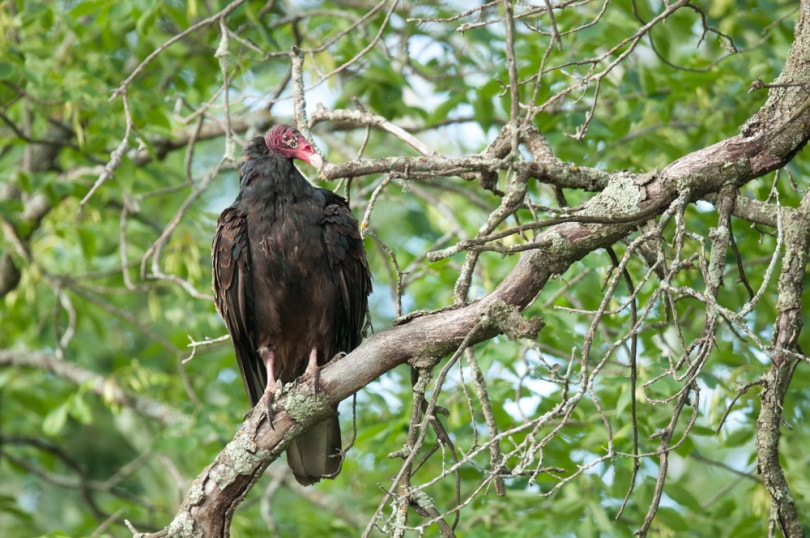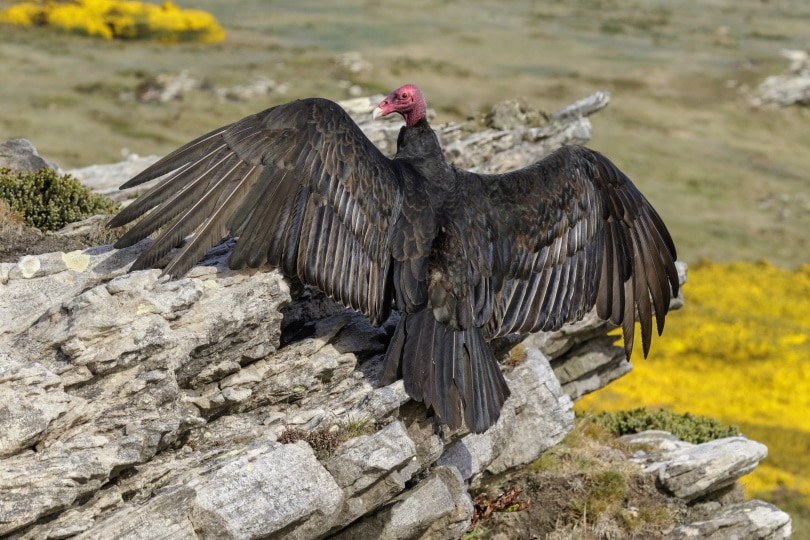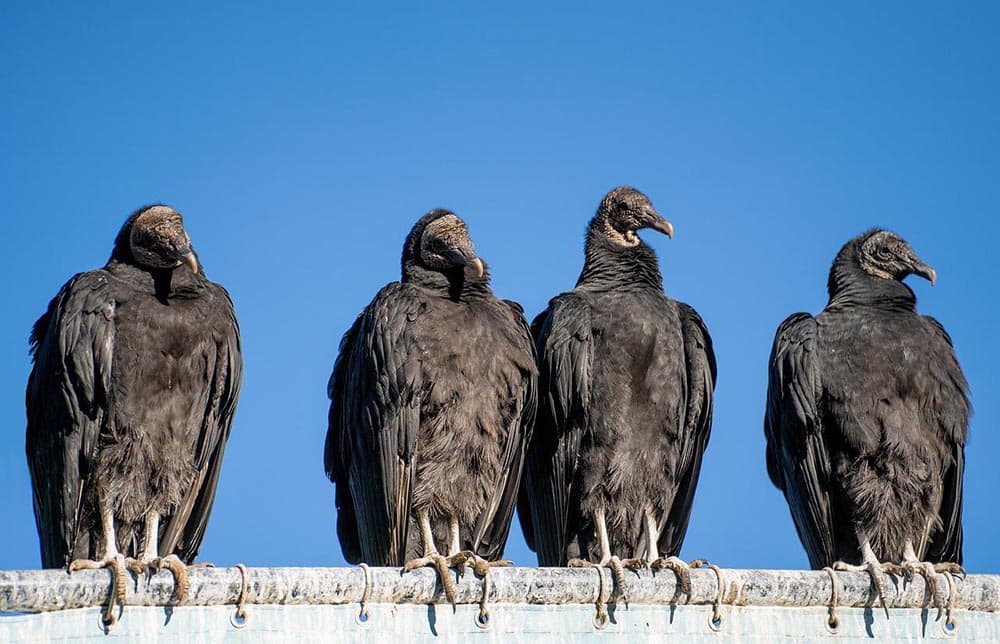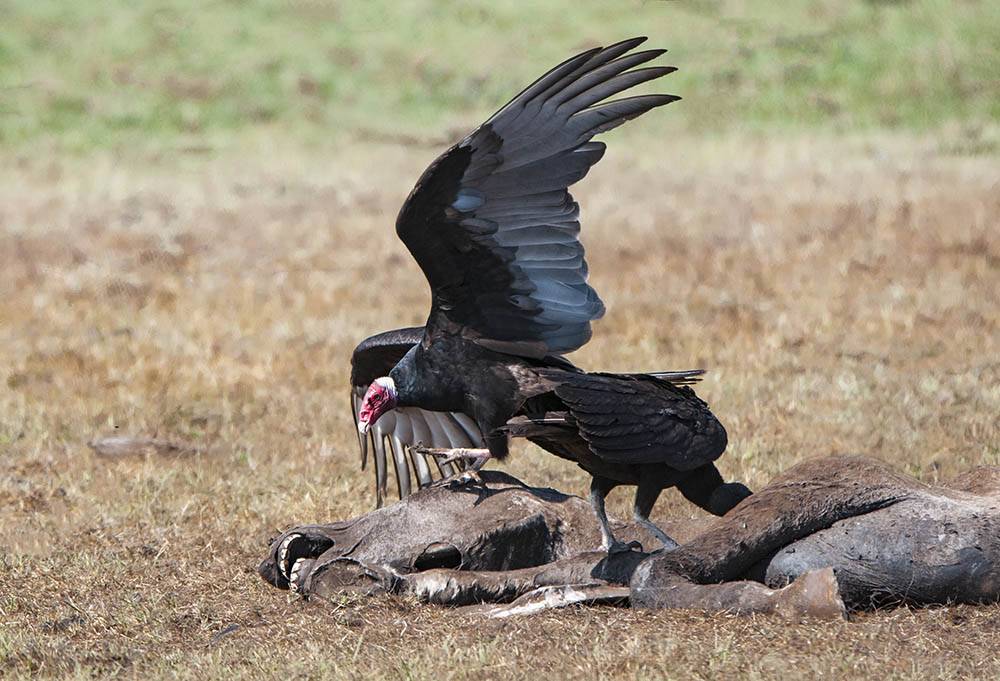18 Interesting & Fun Turkey Vulture Facts You Will Love to Know
Last Updated on

While turkey vultures aren’t most people’s favorite birds, there are still plenty of interesting facts that you can learn about them. Turkey vultures are a critical part of ecosystems throughout North and South America.
But what do they do, how do they do it, and what else should you know about these birds? We break it all down for you here.

The 18 Turkey Vulture Facts
1. They Travel From Argentina to Canada
Turkey vultures are a New World bird with an incredible range. While they don’t have much relation to the vultures over in Europe or Asia, they will travel all the way down to the southernmost tip of Argentina, and they have breeding grounds as far north as Canada.
Turkey vultures travel all over both North and South America, so if you’re on that side of the world, there’s a good chance that you’ll see them.

2. The Turkey Vulture Is Related to the Stork
While you might think that the turkey vulture is related to other large birds, like hawks or the vultures in Europe or Asia, the truth is that its closest relative is the stork. It’s not really what you think of with the turkey vulture, but the DNA evidence doesn’t lie!
3. Turkey Vultures Have a Bald Head
If you’ve ever seen a turkey vulture, you probably noticed that it doesn’t have any feathers on its head. But there’s a reason for this: Carrion doesn’t stick to the skin as well as it does to feathers, which is a big deal because turkey vultures dig their head into their food.

4. It Can’t Kill Prey
Most scavenger birds will kill smaller prey if they’re not finding the food that they need. However, the turkey vulture is the only scavenger bird that can’t kill its prey. Their feet are much closer to that of a chicken than to a bird of prey, so they don’t have the weaponry for it.
5. It’s Really Big
The turkey vulture is big — really big. It stands between 2 and 2.5 feet long and weighs close to 4.5 pounds. Even more impressive is its wingspan, which can reach between 5.5 and 6 feet wide!

6. Both Males And Females Care for the Eggs
Not only are turkey vultures monogamous, meaning they mate for life, but both parents also incubate the eggs and care for their young. They feed regurgitated food to their young, and it’s an effort that both parents partake in.
7. It Can Smell Really Well
Most birds can barely smell anything. That’s not the case for the turkey vulture. They have an especially keen sense of smell that they use to find fresh food, typically in just 12 to 24 hours.

8. It Prefers Fresh Carrion
The turkey vulture might be a scavenger, but that doesn’t mean they’ll eat anything. Turkey vultures won’t eat rotten carcasses, and they prefer to eat from carcasses that are just a day or two old.
9. It Spreads Its Wings in the Morning to Warm Up
If you know where turkey vultures nest and watch them in the morning, you’ll see them spread their wings for a while to warm up. There are a few other reasons that they do this posture, including to absorb solar radiation.

10. A Group of Turkey Vultures Feeding Is a “Wake”
It’s a bit of a morbid term, but it’s not hard to see why someone would call a group of feeding turkey vultures a wake. But what is interesting is that this is the only time that you would call them that term.
11. A Group of Turkey Vultures Flying Is “Kettles”
When turkey vultures are feeding, they’re a part of a wake, but when they’re flying, they’re a kettle. That’s the only time when you’d refer to them as a kettle of vultures.

12. A Group of Turkey Vultures Resting Is a “Committee”
Feeding vultures are a wake, flying turkey vultures are a kettle, and a group of perched turkey vultures is a committee. That’s the final name for a group of turkey vultures, and three names are more than enough!
13. It Can Fly 200 Miles a Day
With a range that extends from Argentina to Canada, turkey vultures need to be able to cover huge distances. Traveling 200 miles in a single day certainly counts as that! Being able to travel this long and far helps them migrate and find the food that they need to eat.

14. It Lives a Long Time
Some birds only live for a few years, but that’s not the case with turkey vultures. They live for an average of 10 to 16 years in the wild and as long as 30 years in captivity.
15. It Helps Prevent Disease
Turkey vultures have a bad reputation as birds that spread disease because they eat carrion. The problem is that it’s simply not true. The turkey vulture’s digestive system is incredibly thorough, effectively eliminating any disease.
Also, since turkey vultures eat carcasses before they rot too much, they effectively stop new diseases from occurring and spreading. Turkey vultures play environmental cleanup, making them a useful and effective part of the ecosystem.

16. It Can Fly 60 Miles per Hour
With large powerful wings, the turkey vulture can really move when it needs to. When ravens or jays try to attack it, it can fly up to 60 miles per hour to get away. That’s one fast bird!
17. Turkey Vultures Can See Up to 4 Miles
Not only can turkey vultures use their keen sense of smell to find food, but they also have extraordinary eyesight. In open areas, a turkey vulture can spot something just 3 feet wide when they’re 4 miles out. That makes it easy for them to track down and pinpoint their next meal.

18. Turkey Vultures Mate for Life
Not only do male and female turkey vultures equally partake in raising their young, but they also mate for life. They even reuse the same nest year after year after a bit of cleaning up and upkeep.
While a turkey vulture will sometimes find a new mate if its original partner dies, this is about the only time that a turkey vulture changes partners.

Final Thoughts
Hopefully after reading this, you have a new appreciation for turkey vultures. They’re not pests or bad omens, and they don’t spread disease.
Without these massive birds, we’d have far more problems to figure out!
Featured Image Credit: Nancy Bauer, Shutterstock
Table of Contents
- The 18 Turkey Vulture Facts
- 1. They Travel From Argentina to Canada
- 2. The Turkey Vulture Is Related to the Stork
- 3. Turkey Vultures Have a Bald Head
- 4. It Can’t Kill Prey
- 5. It’s Really Big
- 6. Both Males And Females Care for the Eggs
- 7. It Can Smell Really Well
- 8. It Prefers Fresh Carrion
- 9. It Spreads Its Wings in the Morning to Warm Up
- 10. A Group of Turkey Vultures Feeding Is a “Wake”
- 11. A Group of Turkey Vultures Flying Is “Kettles”
- 12. A Group of Turkey Vultures Resting Is a “Committee”
- 13. It Can Fly 200 Miles a Day
- 14. It Lives a Long Time
- 15. It Helps Prevent Disease
- 16. It Can Fly 60 Miles per Hour
- 17. Turkey Vultures Can See Up to 4 Miles
- 18. Turkey Vultures Mate for Life
- Final Thoughts
About the Author Robert Sparks
Robert’s obsession with all things optical started early in life, when his optician father would bring home prototypes for Robert to play with. Nowadays, Robert is dedicated to helping others find the right optics for their needs. His hobbies include astronomy, astrophysics, and model building. Originally from Newark, NJ, he resides in Santa Fe, New Mexico, where the nighttime skies are filled with glittering stars.
Related Articles:
10 Types of Hummingbirds in Arkansas (With Pictures)
8 Types of Hummingbirds in Nebraska (With Pictures)
5 Types of Hummingbirds in Idaho (With Pictures)
3 Types of Hummingbirds in Mississippi (With Pictures)
8 Types of Hummingbirds in Kansas (With Pictures)
5 Types of Hummingbirds in West Virginia (With Pictures)
5 Types of Hummingbirds in Ohio (With Pictures)
Where Do Nuthatches Nest? Nuthatch Nesting Habits Explained
